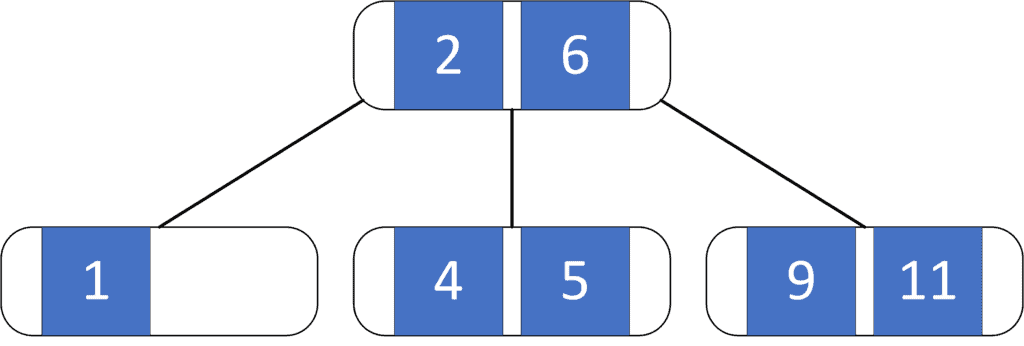1. 概述
在本教程中,我们将讨论树结构中两个常见概念:阶(Order)和度(Degree)。
我们会分别定义这两个概念,通过示例说明它们的含义,并讲解如何计算一棵树的度,以及相关算法的时间复杂度。
2. 树的阶(Order)
2.1 定义
树的阶(Order)指的是树中任意节点所能拥有的最大子节点数。换句话说,如果一棵树的阶为 N,那么该树中所有节点的子节点数量都不能超过 N。
例如,B-树(B-Tree)中经常使用“阶”这个概念。当我们说一个 B-树是阶为 N 的树时,意味着它的每个节点最多可以有 N 个子节点。
2.2 示例
二叉搜索树(Binary Search Tree)是一种阶为 2 的树,因为每个节点最多有两个子节点:

B-树(B-Tree)中,若阶为 3,则每个节点最多可以有 3 个子节点:

3. 树的度(Degree)
3.1 定义
树的度是指树中某个节点的最大子节点数。更具体地说,树的度是整棵树中所有节点的度中的最大值。
节点的度定义为其拥有的子节点数量。因此,要得到一棵树的度,我们需要遍历整棵树,计算每个节点的度,然后取最大值。
3.2 算法实现
我们可以使用深度优先搜索(DFS)来遍历整棵树,并递归地计算每个节点的度:
algorithm ComputeDegree(node, children)
// INPUT
// node = a node in the tree
// children = a map associating each node with its children
// OUTPUT
// The maximum degree found in the tree rooted at node
degree <- length(children[node])
for child in children[node]:
degree <- MAX(degree, ComputeDegree(child, children))
return degree
Java 实现示例:
public class TreeDegreeCalculator {
public static int computeDegree(int node, Map<Integer, List<Integer>> children) {
int maxDegree = children.getOrDefault(node, Collections.emptyList()).size();
for (int child : children.getOrDefault(node, Collections.emptyList())) {
maxDegree = Math.max(maxDegree, computeDegree(child, children));
}
return maxDegree;
}
}
3.3 时间复杂度分析
- 时间复杂度为 **O(N + M)**,其中
N是节点数,M是边数。 - 因为树中边数
M = N - 1,所以也可以简化为 **O(N)**。 - 我们每个节点和边都只访问一次,这与 DFS 遍历的时间复杂度一致。
4. 总结
| 概念 | 含义 | 计算方式 |
|---|---|---|
| 阶(Order) | 节点最多可拥有的子节点数 | 由树结构定义决定(如 B-Tree 阶为 N) |
| 度(Degree) | 整棵树中节点度的最大值 | 遍历所有节点,取最大子节点数 |
✅ 小贴士:
- “阶”是结构定义,通常用于 B-树、B+ 树等数据结构。
- “度”是统计性质,通常用于分析树的形态,比如判断是否为二叉树等。
⚠️ 踩坑提醒:
- 不要混淆“阶”和“度”,它们虽然都涉及子节点数量,但一个是限制条件,一个是实际统计结果。
- 在实际编程中,尤其在树结构的构建和验证阶段,这两个概念可能会导致逻辑错误,务必区分清楚。